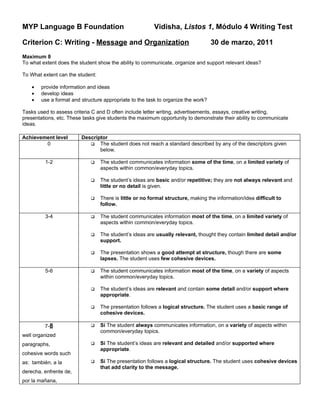
C writing message foundation vidisha
- 1. MYP Language B Foundation Vidisha, Listos 1, Módulo 4 Writing Test Criterion C: Writing - Message and Organization 30 de marzo, 2011 Maximum 8 To what extent does the student show the ability to communicate, organize and support relevant ideas? To What extent can the student: • provide information and ideas • develop ideas • use a format and structure appropriate to the task to organize the work? Tasks used to assess criteria C and D often include letter writing, advertisements, essays, creative writing, presentations, etc. These tasks give students the maximum opportunity to demonstrate their ability to communicate ideas. Achievement level Descriptor 0 The student does not reach a standard described by any of the descriptors given below. 1-2 The student communicates information some of the time, on a limited variety of aspects within common/everyday topics. The student’s ideas are basic and/or repetitive; they are not always relevant and little or no detail is given. There is little or no formal structure, making the information/idea difficult to follow. 3-4 The student communicates information most of the time, on a limited variety of aspects within common/everyday topics. The student’s ideas are usually relevant, thought they contain limited detail and/or support. The presentation shows a good attempt at structure, though there are some lapses. The student uses few cohesive devices. 5-6 The student communicates information most of the time, on a variety of aspects within common/everyday topics. The student’s ideas are relevant and contain some detail and/or support where appropriate. The presentation follows a logical structure. The student uses a basic range of cohesive devices. 7-8 Sí The student always communicates information, on a variety of aspects within common/everyday topics. well organized paragraphs, Sí The student’s ideas are relevant and detailed and/or supported where appropriate. cohesive words such as: también, a la Sí The presentation follows a logical structure. The student uses cohesive devices that add clarity to the message. derecha, enfrente de, por la mañana,